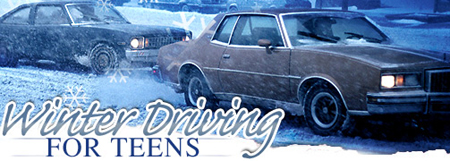
Tips
for Teens Driving During Winter Conditions
The
American Automobile Association (AAA) recently reported that teen drivers are
quickly becoming the single most dangerous group of motorists on the road. This
danger only increases during winter weather and hazardous road conditions. According
to Timothy Smith, author of "Crashproof Your Kids: Make Your Teen a Safer,
Smarter Driver," parents can help reduce this danger by properly preparing
their teens for winter driving conditions."Teenagers need good car handling
skills and safe attitudes," Smith said. "Only parents can provide the
time and restrictions necessary for them to become safer, smarter drivers." When
snowy, hazardous conditions set in, Smith recommends parents instruct their teen
drivers on safety winter driving practices. According to the author, many young
drivers feel overconfident with four-wheel drive vehicles, driving unsafe speeds.
Additionally, if the vehicle does start to slide, most beginning drivers will
hit their brakes and oversteer, causing skids to worsen. "Four
wheel drive does little to help you stop more effectively in slippery conditions
at normal driving speeds," he said. Smith
recommends drivers immediately lay off the gas and brakes during a skid. By turning
the steering wheel in slowly in the same direction, drivers can regain control
of their vehicle. According to the
author, parents need to also warn their young drivers about checking tire traction
before entering traffic, even at low speeds.
"Sometimes snow can have
reasonable traction, or a seemingly dry road can be treacherous," Smith said. Parents
can help prepare their young drivers for winter driving conditions with these
basic safety tips. Winter
Driving Tips Reduce
speed. Don't be pressured by cars behind you to drive faster than you
feel comfortable with. Always leave a few minutes early for your destinations
to avoid being late due to winter roadways.
Increase
following distance. Add another second or more to the normal three-second
following distance. Keeping a safe distance between you and the car in front of
you ensures you can stop fast enough, even on icy roads.
Brake
more carefully. Give yourself more braking room, and remember not to
pump anti-lock brakes. Providing constant pressure to your brakes gives you better
braking and steering control.
Beware of ice patches.
Know where ice forms most readily such as bridges, overpasses, shady spots and
intersections.
In snow, drive in the ruts. The traction is better when you
drive in ruts, or tire tracks. Also, make sure you change lanes slowly and smoothly.
Stay
home! Postpone or avoid all but the most essential travel.
Parents can read more about the Crashproof
Plan outlining behind-the-wheel exercises and strategies to reduce the
risks of driver error, speeding, drugs and alcohol, distractions and road rage.
Source — Crashproof
Your Kids |